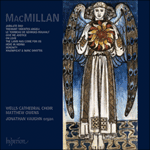Serenity was written for the 150th anniversary celebrations of St Aloysius’ College in Glasgow, the school MacMillan’s children attended. St Aloysius is an independent Catholic school founded in 1859 which has a spacious, domed neo-baroque chapel. MacMillan’s work is a setting of two texts: one by St Thomas Aquinas (1225–1274) in Latin, and the other attributed to Reinhold Niebuhr (1892–1971) in English. The Aquinas text is a well-known Benediction hymn and Niebuhr’s famous prayer, universally known as ‘Serenity’, gives MacMillan his title. The first section setting Aquinas’s words is a good example of MacMillan’s ability to write a straightforward setting. Indeed, MacMillan uses the piece frequently with his own church choir in Glasgow. It is, in effect, harmonized chant doubled by the organ. In the second section, to Neibuhr’s words, the sopranos sing an ornamented chant—unmistakeably redolent of MacMillan—over an organ pedal point. This pairing is repeated, with the ‘O salutaris hostia’ hymn acting as a refrain between verses of Neibuhr’s ‘Serenity’. In the last verse the sopranos descant the three key words of the opening of the poem—‘serenity, courage, wisdom’—over the lower voices, which sing a Latin doxology in unison using the melody given to the Latin words throughout. As the descant dies away so the Latin words grow to a strong conclusion and the organ carries the anthem loudly to its end.
from notes by Paul Spicer © 2011
Serenity a été écrit pour les célébrations du 150ème anniversaire de St Aloysius’ College à Glasgow, l’école où allaient les enfants de MacMillan. St Aloysius est une école catholique indépendante fondée en 1859, dotée d’une vaste chapelle néobaroque en dôme. L’œuvre de MacMillan met en musique deux textes: l’un de saint Thomas d’Aquin (1225–1274) en latin, et l’autre attribué à Reinhold Niebuhr (1892–1971) en anglais. Le texte de saint Thomas d’Aquin est un hymne de glorification fameux et la célèbre prière de Niebuhr, universellement connue sous l’appellation «Serenity», donne son titre à l’œuvre de MacMillan. La première section sur les paroles de saint Thomas d’Aquin est un bon exemple de la faculté de MacMillan d’écrire une musique simple. En fait, MacMillan utilise souvent cette pièce avec son propre chœur d’église à Glasgow. C’est, dans le fond, une mélopée harmonisée doublée par l’orgue. Dans la seconde section, sur le texte de Neibuhr, les sopranos chantent une mélopée ornementée—typique de MacMillan—sur une pédale de l’orgue. Cet appariement se répète, l’hymne «O salutaris hostia» servant de refrain entre les versets de «Serenity» de Neibuhr. Dans le dernier verset, les sopranos accompagnent en déchant les trois mots clefs du début du poème—«serenity, courage, wisdom» («sérénité, courage, sagesse»)—sur les voix graves, qui chantent une doxologie latine à l’unisson en utilisant la mélodie donnée aux mots latins du début à la fin. Lorsque le déchant disparaît, les mots latins s’élèvent à une forte conclusion et l’orgue mène l’hymne à sa fin d’une voix forte.
extrait des notes rédigées par Paul Spicer © 2011
Français: Marie-Stella Pâris
Serenity entstand anlässlich der Feierlichkeiten zum 150-jährigen Bestehen des St.-Aloysius-College in Glasgow, jener Schule, die auch MacMillans Kinder besuchten. St. Aloysius ist eine 1859 gegründete katholische Privatschule, zu der eine großzügig dimensionierte neobarocke Kapelle mit einer Kuppel gehört. MacMillans Werk ist eine Vertonung von zwei Texten: eines lateinischen von Thomas von Aquin (1225–1274) sowie eines englischen, der Reinhold Niebuhr (1892–1971) zugeschrieben wird. Bei dem aquinischen Text handelt es sich um einen bekannten Segenshymnus, und Niebuhrs berühmtes Gebet, allgemein als „Gelassenheitsgebet“ („Serenity“) bekannt, gibt dem Stück seinen Titel. Der erste Abschnitt, dem Aquins Text zugrunde liegt, ist ein gutes Beispiel für MacMillans Fähigkeit, klar und einfach zu vertonen. MacMillan führt das Stück selber häufig mit seinem eigenen Kirchenchor in Glasgow auf. Im Grunde handelt es sich um harmonisierte Psalmodie, die von der Orgel verdoppelt wird. Im zweiten Abschnitt auf Niebuhrs Text singen die Soprane über einem Orgelpunkt eine—unverkennbar an MacMillan erinnernde—verzierte Psalmodie. Diese Kombination wiederholt sich, wobei der Hymnus „O salutaris hostia“ als Refrain zwischen den Strophen von Niebuhrs „Serenity“ fungiert. In der letzten Strophe diskantieren die Soprane die drei Schlüsselworte vom Anfang des Gedichts—„serenity“ („Gelassenheit“), „courage“ („Mut“) und „wisdom“ („Weisheit“)—, während die tieferen Stimmen darunter im Unisono eine lateinische Doxologie auf die Melodie singen, die durchgängig für den lateinischen Text verwendet wird. Mit Verklingen des Diskants steigern sich die lateinischen Worte zu einem kraftvollen Finale, und die Orgel bringt das Werk lautstark zum Abschluss.
aus dem Begleittext von Paul Spicer © 2011
Deutsch: Arne Muus


 MacMillan: Choral Music
MacMillan: Choral Music
